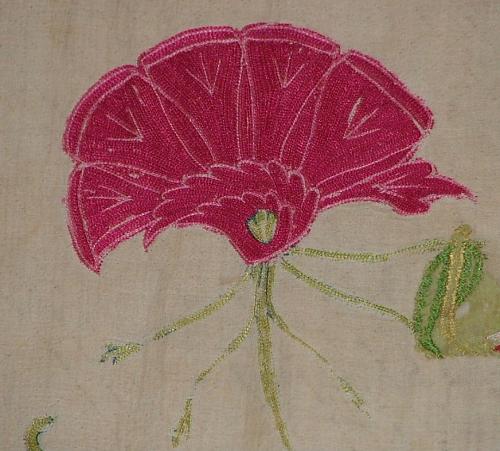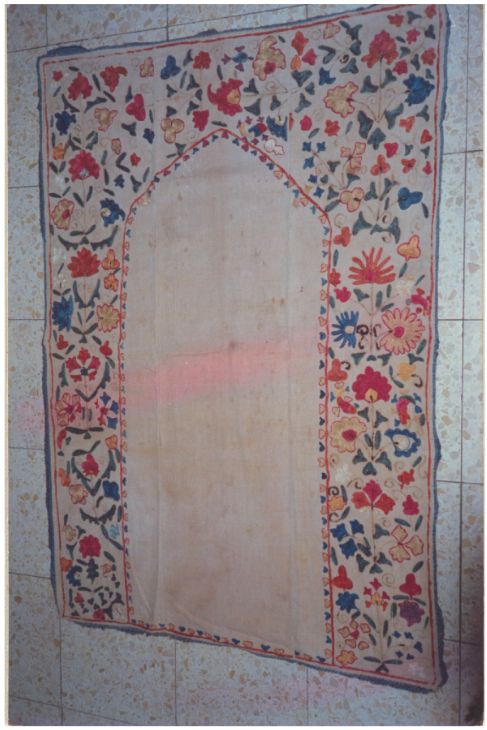Here is Richard's fourth mystery textile:

Mystery Textile Number 4
Hi People
Here is Richard's fourth mystery textile:
How about part of a suzanni embroidery?
Tim
Ottoman suzani? I say Ottoman for the stylization of the flower. I’m not sure
if the term "suzani" can be applied to an Ottoman textile, though.
As a
matter of fact… Where we can use correctly the term
"suzani"?
Regards,
Filiberto
Hi Filiberto
"Suzani" means needlework. So the term can apply to any
embroidery.
Regards
Steve Price
Dear Turkotekees,
you must wait a day or two for the next clue but in
the meantime a verbal clue.
think of monuments of eternal
love.
best
richard farber
Oi, Oi, Oi,
So easy.
Buddha's pyjama jacket
Best
regards,
Vincent
Dear folks -
Following the theory that resources should help I have
consulted seven books on Turkish and Greek Island embroidery and Islamic
textiles in general, although suspecting that Turkish ones are most likely.
I still don't really have a clue.
I might be tempted to say that
this is another Turkish tea towel but it seems like a field design to me rather
than a border and the hint provided presses one well beyond tea towels.
A
bed hanging?
Regards,
R. John Howe
Richard sent another clue:
Hi Richard -
Seems more like an echo than a new clue.
R. John
Howe
Echo of something like this?
Dear Mr. Howe
this is an important NEW clue . . . with vital NEW
information . . . when you know the answer you shall see.
Dear Mr.
Boncompagni
the mystery textile in in definately not an ECHO of the
textile that you have shown --- it looks familiar.
Hi,
Monuments of enternal love?
Can't be: Christian, Islamic,
Atheist.
So Buddhist or Hinduism?
Vincent
Hi People
Here's Richard's third clue on this piece:
Mumble, mumble…
"Monument of eternal love" PLUS this kind of decoration
makes me think to the Taj Mahal…
Mughal embroidery! Indian, at
least.
Regards,
Filiberto
Flowers, especially smaller ones, look Uzbek rather than Mughal to me. Stephen
New image:
I insist: Mughal style silk embroidery on cotton, 18th century.

Probably a “niche” form, like
the first image above.
Regards,
Filiberto
eternal love and botanic images
dear all
fileberto is almost there but not quite . . . a verbal clue
or two
think again of the other clues
think of botanical
drawings
good luck
richard farber
n.b. new
objects and clues soon . . .
Mughal embroidery with garden panel design? 
Filiberto
dear filiberto and other turkotekees
filiberto's answer had some
truth in it . . . . another verbal clue
think of the
exhibition flowers underfoot, indian carpets of the mughal era
there
was considerable discussion of it on this site if i remember correctly . .
.
in the book are knotted versions of this embroidery . . . hows that for
a clue
best
richard farber

I don’t have
the book, but I had a look at the review of "Flowers Underfoot: Indian Carpets
of the Mughal Era"on Turkotek:
http://www.turkotek.com/journal/crrev.html
Are you
speaking of this rug?
If so, yours is a prayer cloth!
Regards,
Filiberto 
dear turkotekees . . . .
an answer must have
what the
object is
attribution
age
[it might have the image of a
companion piece --- ]
so to sum up for filiberto . . . .
the
mystery object is a prayer cloth
mughal
18th
cent.
trumpets
drums
tablas
and a long sitar
passage BUT . . .
melodramatic pause
that is not the correct
answer !!!!!!!! [only one out of three is correct]
i iwll post the
complete image tomorrow . . . . but i believe someone might still get the
correct answer from the available clues but visual AND VERBAL.
in the
meantime might i suggest that objects numbers 8, 9 and 10 are now available in
the "NAME THAT TEXTILE" attribution
game.
sincerely
richard farber
as to
filiberto's direct question - i was not particularly thinking of that rug . .
although i could have been . . . i was thinking about a fragment on page 24-25
where the colors are more similar to the mystery item.
another liittle
clue . . . .gujurati might help
All right, all right! 
Let, say only: Mughal style silk embroidery on cotton, 17th
(OK?)century.
Regards,
Filiberto
dear turkotekees,
the complete image of the textile is the final clue.
one crucial bit of information missing from Filiberto's excellent detective
work. . . . look very carefully at the image [clue]
Sincerely,
Richard Farber
Richard -- I give up. "Flowers Under Foot" speaks of the widespread adoption
off naturalistic floral images during the reign of Shah Jahan. The book also
illustrates a number of carpets with similar borders, arches or flower motifs:
but no close woven companion to this embroidery.
This piece does not look
as old to me, and its limited colour palette (with neon-purple on my monitor) is
out of kilter with the examples published by Walker (and by Rosemary Crill in
her book), although in keeping with some of the embroideries exhibited in the
V&A in London.
So perhaps a later version of a design imported from
Persia and adapted under court patronage in accordance with Shah Jahan's
taste.
(PS: my earlier comment to the effect that it looked Uzbek
confused the carpet posted by Filiberto (dubbed "an echo ...") and your posting.
Sorry, this is most certainly not Uzbek).
Hi People
Richard just sent me this image for posting in this
thread:
Steve
Price
dear mr louw
i have asked steve to post a photo of page 224
from
Brend, Barbara Islamic Art British Museum Press London
1991
[by the way a very fine introduction highly
recomended]
on this page you can see the gujarati embroidery that
is promenently displayed in the nehru room of the v and a.
if you
cant make out the text it reads:
"cotton prayer mat, mughal with
gujarati style silk embroidery, second half of the 17th cent. The cloth is
worked in chain-stich, and delicate shading effects are created with two blues,
two turquoises, green, yellow, raspberry and pink. the lilly is surrounded by
chinoiserie clouds."
the clouds were one of the clues
the
piece that i put up in the game is part of a saf [have a look at the corners and
you can see where they are not closed on one side where the other panels would
have continued. . . it really is 17th cent. according to experts who have viewed
it.
carpets have a different aesthetic than embroidery and i agree it is
not readily clear that pieces from the same period belong together.
it is
often the case that early pieces in good condition often seem not to be as old
as they are . . . the colors of the two gujarati embroideries from the 17cent.
that i have seen in person look as if they were embroidered yesterday. the same
is often the case antique carpets. . .
indian block prints [something
that i looking into] of the early 19th cent. if in good condition almost always
look brighter [and easily mistaken as newer for those who dont know that type of
work] than those made a cent. later.
early 19th cent. susanis that were
kept out of the sunlight often look newer brighter than those of the early
twentieth cent.
sorry about the long winded
answer
best
richard farber
yes i also agree with you
that these 17th cent. embroiedered pieces are much less crowed than those of the
18th cent.
the colors on the monitor are not exact of course . . .
the closeups of the clues are better.
Thanks -- its lovely, absolutely georgous. I have spent quite a bit of time
in the Nehru room at the V&A but dont remember this piece. (90% due to my
poor memory. 10% due to the V&A's policy of keeping the lights so low that
one needs almost to bring a torch javascript:smilie(' ')
')
Will check this out next time I
have the opportunity.
__________________
Stephen
Louw